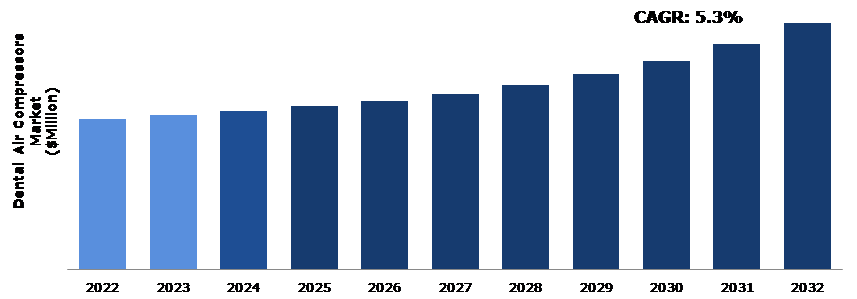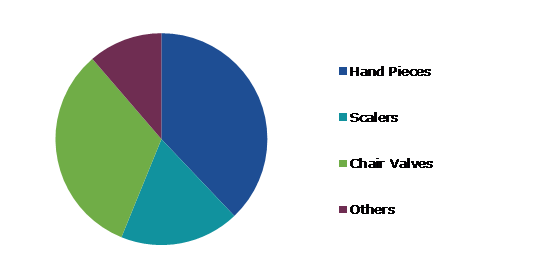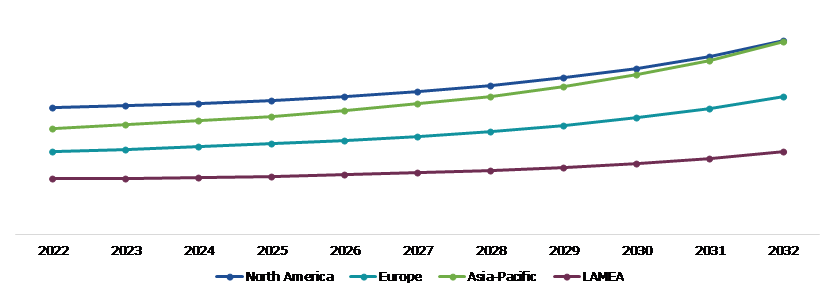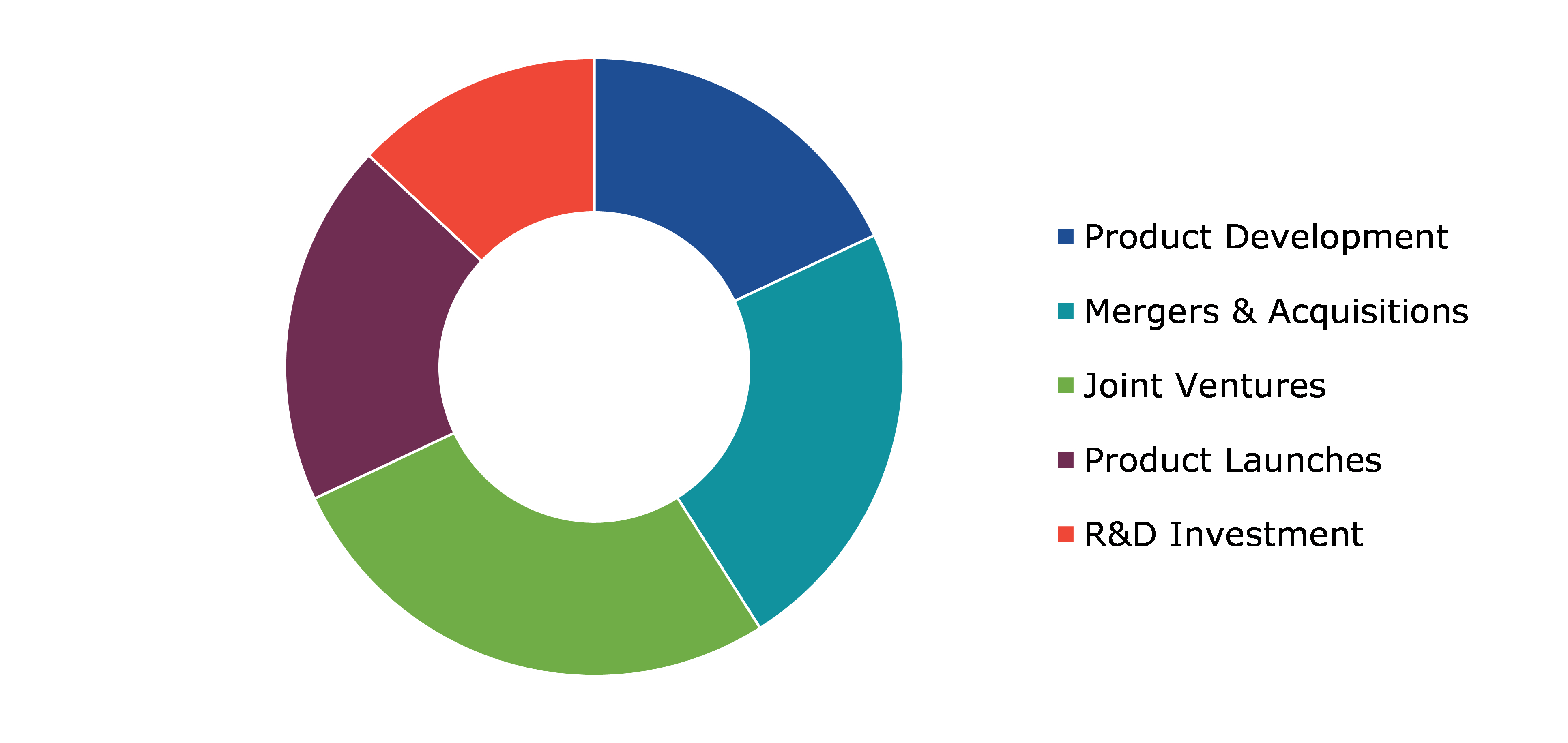Dental Air Compressors Market Report
RA09238
Dental Air Compressors Market by Type (Dental Lubricated Compressors and Dental Oil-Free Compressors), Technology (Desiccant Based Compressors and Membrane Based Compressors), Application (Hand Pieces, Scalers , Chair Valves, and Others), and Region (North America, Europe, Asia-Pacific, and LAMEA): Global Opportunity Analysis and Industry Forecast, 2023-2032
Dental Air Compressors Overview
Dental air compressors are mechanical devices that create and distribute a steady flow of compressed air for dental operations. These compressors are designed to meet the severe standards of the dentistry sector, offering high-quality, oil-free, and moisture-free air. This pure air supply is required for duties such as dental handpiece operation, air abrasion systems, and chair-side maintenance, all of which contribute to excellent patient care and ensure the longevity and performance of dental equipment. Dental air compressors' principal role is to deliver compressed air to drive dental handpieces, suction devices, and numerous other dental treatment tools. This pressurized air is required for the accurate functioning of drills, scalers, air-water syringes, and other tools. These compressors' air quality and pressure consistency are crucial, especially during delicate treatments including dentistry root canals, extractions, and restorative surgery. Furthermore, dental air compressors assist the functioning of dental vacuum systems, which are critical for keeping a clean and dry mouth environment throughout various treatments.
Global Dental Air Compressors Market Analysis
The global dental air compressors market size was $340.3 million in 2022 and is predicted to grow with a CAGR of 5.3%, by generating a revenue of $555.9 million by 2032.
Source: Research Dive Analysis
COVID-19 Impact on Global Dental Air Compressors Market
The COVID-19 pandemic led to an increase in emphasis on infection control and significance of keeping a clean and sterile environment in dentistry facilities. Dental air compressors play an important role in dental procedures by delivering the air required while using various dental tools. Dentists and dental staff had to ensure that their compressors were well-maintained and in compliance with infection control requirements, since polluted air or equipment might represent a substantial danger to patients and staff. This entailed paying more attention to maintenance schedules, the quality of air filtering systems, and the overall dependability of dental air compressors.
Rising Awareness Regarding Precision Dentistry to Drive the Market Growth
Precision is essential in dentistry, and dental air compressors play an important role in establishing exact control throughout various treatments. They allow dentists to produce regular air pressure and flow, which is critical for operations such as cleaning, drying, and polishing teeth, as well as operating dental handpieces and drills. The increased awareness regarding the benefits of individualized treatment programs among both dental practitioners and patients is one of the primary reasons driving the demand for precision dentistry. Dentists are increasingly using diagnostic methods that provide a complete picture of a patient's oral health, such as hereditary variables, microbial makeup, and biomechanics. This data enables the creation of exact treatment plans, where the usage of dental air compressors becomes critical for operations such as air abrasion, air-driven handpieces, and precision-controlled drying of the treatment area. As the need for personalized treatment increases, so does the demand for dental air compressors.
Air Quality and Contamination Concerns to Restrain the Growth of the Dental Air Compressors Market
A major concern is microbial contamination within the compressor system. Dental air compressors may become an incubator for germs, viruses, and fungus if not properly maintained and monitored on a regular basis. The wet atmosphere and high temperatures within the compressor provide an excellent setting for microbial development, potentially contaminating the compressed air that comes into direct contact with dental tools and patient oral cavities. This issue is worsened by the fact that dental patients frequently have impaired immune systems, leaving them more susceptible to infections. Therefore, there is a critical need for continuing innovations in compressor design and maintenance practices to reduce the danger of microbiological contamination. Another constraint derives from the presence of oil in compressed air, which makes preserving air quality in dental settings difficult. Lubricated compressors, which are often used in dentistry practices, might inject traces of oil into the compressed air stream. Inhaling or ingesting oil-contaminated air during dental treatments can have negative health consequences for patients, including respiratory difficulties and allergic responses.
Rising Dental Procedures to Drive Excellent Opportunities in the Market
Dental operations have increased due to greater awareness regarding oral health and its direct influence on overall well-being. Patients are becoming more proactive in obtaining dental treatment, which includes anything from basic check-ups and cleanings to complex oral procedures. Because of the increase in dental treatments, dependable and high-performance dental air compressors are required to power a wide range of dental instruments, from drills to sterilization equipment. The worldwide population is aging, and with it comes an increase in demand for dental care. Elderly patients may require more sophisticated dental operations such as implants, bridges, and other restorative treatments. These treatments typically need the use of sophisticated equipment, such as air-driven dental handpieces and syringes, which necessitate the use of efficient and dependable dental air compressors. Dental tourism has become a global trend, with people travelling to other countries in search of cost-effective and high-quality dental operations. Many dental clinics and hospitals in major dental tourism destinations rely on innovative technologies, such as dental air compressors, to provide competitive treatments that attract foreign customers. This movement creates chances for dental air compressor manufacturers to supply cutting-edge equipment to major global healthcare hubs.
Global Dental Air Compressors Market Share, by Type, 2022
Source: Research Dive Analysis
The dental oil free compressors sub-segment accounted for the highest market share in 2022. Dental oil-free compressors are intended to provide a clean and contaminant-free supply of compressed air for a wide range of dental applications. One of their most notable benefits is the lack of lubricating oil in the compression process. The key advantage of dental oil-free compressors is their unwavering dedication to keeping compressed air purity. They do this through the use of cutting-edge technologies such as oil-free pistons or scroll compressors. Therefore, dental professionals may execute treatments with confidence, knowing there is no possibility of oil contamination, which can result in difficulties or infections in patients. In addition, oil-free dental compressors provide continuous and dependable performance. They are designed to provide a consistent supply of clean, dry, and oil-free compressed air, ensuring that dental equipment and tools function properly.
Global Dental Air Compressors Market Share, by Technology, 2022
Source: Research Dive Analysis
The desiccant based compressors sub-segment accounted for the highest market share in 2022. As the name implies, desiccant-based air compressors use desiccant materials within the compression system to remove moisture from the incoming air. Desiccant-based compressors excel at supplying the required compressed air quality in dental applications where keeping a dry and contamination-free environment is crucial. Desiccant-based compressors specialize in removing moisture from the air supply. The lack of moisture in the compressed air stream is critical in dental applications to avoid rust and microbial contamination of dental instruments, hence extending their lifespan. Desiccant-based compressors ensure continuous air quality, ensuring that dental operations remain effective and predictable. Desiccant-based compressors are used in root canal therapy to enable exact air-drying of the root canal, which is required for optimal treatment. This is especially helpful for precision operations like crown cementation and root canal treatment.
Global Dental Air Compressors Market Share, by Application, 2022
Source: Research Dive Analysis
The hand pieces sub-segment accounted for the highest market share in 2022. Handpieces are used by dentists to execute a variety of operations, ranging from regular cleanings to complex surgeries. One of the most important purposes of dental air compressors in handpieces is to provide a clean and consistent source of compressed air. This pressurized air is essential for operating the handpiece's turbines, which allow dental burs and other attachments to rotate. These compressors create steady and regulated airflow, allowing dental professionals to do their responsibilities with precision and accuracy, lowering the chance of mistakes and difficulties during treatments. Precision is essential in dentistry, and the handpiece extends the dentist's ability and competence. Handpieces, with their capacity to reach unreachable locations within the oral cavity, allow doctors to perform delicate and intricate work while maintaining patient comfort. Their quickness and precision minimize treatment time and patient discomfort, resulting in higher patient satisfaction and results.
Global Dental Air Compressors Market Size & Forecast, by Region, 2022-2032 ($Million)
Source: Research Dive Analysis
The North America dental air compressors market generated the highest revenue in 2022. The dental industry in this region is also expected to grow due to rising patient awareness. In addition to severe regulatory requirements, North America's dental care community demands eco-friendly and energy-efficient solutions, a trend that has substantially affected the design and production of dental air compressors. Adoption of new technology, such as oil-free compressors, has considerably decreased environmental impact and operational expenses. Furthermore, the healthcare sector in the U.S. is expected to expand in the future due to the presence of established enterprises in the region. Major corporations' strategic activities have propelled market expansion. For example, ELGI Equipment Limited debuted its Rot air brand of air compressors in the U.S. in March 2020 in order to enter the market.
Competitive Scenario in the Global Dental Air Compressors Market
After-sales support and international expansion are common strategies followed by major market players. For instance, in 2021, Dürr Dental introduced a new compressed air system called the Tyscor VS 2, which offers high performance and reliability with low energy consumption. The system is designed to provide a consistent compressed air supply for dental applications.
Source: Research Dive Analysis
Some of the leading dental air compressors oil market players are Midmark Corporation, Gnatus, Air Techniques, Kaeser Dental, Atlas Copco, General Air Products, Inc., Durr Dental, Slovadent, Aixin Medical Equipment Co, Ltd, and Dental EZ Group.
| Aspect | Particulars |
| Historical Market Estimations | 2020-2021 |
| Base Year for Market Estimation | 2022 |
| Forecast Timeline for Market Projection | 2023-2032 |
| Geographical Scope | North America, Europe, Asia-Pacific, and LAMEA |
| Segmentation by Type |
|
| Segmentation by Technology |
|
| Segmentation by Application |
|
| Key Companies Profiled |
|
Q1. What is the size of the global dental air compressors market?
A. The size of the global dental air compressors market was $340.3 million in 2022 and is projected to reach $555.9 million by 2032.
Q2. Which are the major companies in the dental air compressors market?
A. Atlas Copco, Midmark Corporation, and Gnatus are some of the key players in the global dental air compressors market.
Q3. Which region, among others, possesses greater investment opportunities in the future?
A. North America possesses great investment opportunities for investors in the future.
Q4. What will be the growth rate of the Asia-Pacific dental air compressors market?
A. The Asia-Pacific dental air compressors market is anticipated to grow at XX% CAGR during the forecast period.
Q5. What are the strategies opted by the leading players in this market?
A. After-sales support and international expansion are the two key strategies opted by the operating companies in this market.
Q6. Which companies are investing more on R&D practices?
A. Atlas Copco, General Air Products, Inc, and Durr Dental are the companies investing more on R&D activities for developing new products and technologies.
1. Research Methodology
1.1. Desk Research
1.2. Real time insights and validation
1.3. Forecast model
1.4. Assumptions and forecast parameters
1.5. Market size estimation
1.5.1. Top-down approach
1.5.2. Bottom-up approach
2. Report Scope
2.1. Market definition
2.2. Key objectives of the study
2.3. Report overview
2.4. Market segmentation
2.5. Overview of the impact of COVID-19 on global dental air compressors market
3. Executive Summary
4. Market Overview
4.1. Introduction
4.2. Growth impact forces
4.2.1. Drivers
4.2.2. Restraints
4.2.3. Opportunities
4.3. Market value chain analysis
4.3.1. List of raw material suppliers
4.3.2. List of manufacturers
4.3.3. List of distributors
4.4. Innovation & sustainability matrices
4.4.1. Technology matrix
4.4.2. Regulatory matrix
4.5. Porter’s five forces analysis
4.5.1. Bargaining power of suppliers
4.5.2. Bargaining power of consumers
4.5.3. Threat of substitutes
4.5.4. Threat of new entrants
4.5.5. Competitive Rivalry Intensity
4.6. PESTLE analysis
4.6.1. Political
4.6.2. Economical
4.6.3. Social
4.6.4. Technological
4.6.5. Legal
4.6.6. Environmental
4.7. Impact of COVID-19 on dental air compressors market
4.7.1. Pre-covid market scenario
4.7.2. Post-covid market scenario
5. Dental Air Compressors Market Analysis, by Type
5.1. Overview
5.2. Dental Lubricated Compressors
5.2.1. Definition, key trends, growth factors, and opportunities
5.2.2. Market size analysis, by region, 2022-2032
5.2.3. Market share analysis, by country, 2022-2032
5.3. Dental Oil-Free Compressors
5.3.1. Definition, key trends, growth factors, and opportunities
5.3.2. Market size analysis, by region, 2022-2032
5.3.3. Market share analysis, by country, 2022-2032
5.4. Research Dive Exclusive Insights
5.4.1. Market attractiveness
5.4.2. Competition heatmap
6. Dental Air Compressors Market Analysis, by Technology
6.1. Overview
6.2. Desiccant Based Compressors
6.2.1. Definition, key trends, growth factors, and opportunities
6.2.2. Market size analysis, by region, 2022-2032
6.2.3. Market share analysis, by country, 2022-2032
6.3. Membrane Based Compressors
6.3.1. Definition, key trends, growth factors, and opportunities
6.3.2. Market size analysis, by region, 2022-2032
6.3.3. Market share analysis, by country, 2022-2032
6.4. Research Dive Exclusive Insights
6.4.1. Market attractiveness
6.4.2. Competition heatmap
7. Dental Air Compressors Market Analysis, by Application
7.1. Overview
7.2. Hand Pieces
7.2.1. Definition, key trends, growth factors, and opportunities
7.2.2. Market size analysis, by region, 2022-2032
7.2.3. Market share analysis, by country, 2022-2032
7.3. Scalers
7.3.1. Definition, key trends, growth factors, and opportunities
7.3.2. Market size analysis, by region, 2022-2032
7.3.3. Market share analysis, by country, 2022-2032
7.4. Chair Valves
7.4.1. Definition, key trends, growth factors, and opportunities
7.4.2. Market size analysis, by region, 2022-2032
7.4.3. Market share analysis, by country, 2022-2032
7.5. Others
7.5.1. Definition, key trends, growth factors, and opportunities
7.5.2. Market size analysis, by region, 2022-2032
7.5.3. Market share analysis, by country, 2022-2032
7.6. Research Dive Exclusive Insights
7.6.1. Market attractiveness
7.6.2. Competition heatmap
8. Dental Air Compressors Market, by Region
8.1. North America
8.1.1. U.S.
8.1.1.1. Market size analysis, by Type, 2022-2032
8.1.1.2. Market size analysis, by Technology, 2022-2032
8.1.1.3. Market size analysis, by Application, 2022-2032
8.1.2. Canada
8.1.2.1. Market size analysis, by Type, 2022-2032
8.1.2.2. Market size analysis, by Technology, 2022-2032
8.1.2.3. Market size analysis, by Application, 2022-2032
8.1.3. Mexico
8.1.3.1. Market size analysis, by Type, 2022-2032
8.1.3.2. Market size analysis, by Technology, 2022-2032
8.1.3.3. Market size analysis, by Application, 2022-2032
8.1.4. Research Dive Exclusive Insights
8.1.4.1. Market attractiveness
8.1.4.2. Competition heatmap
8.2. Europe
8.2.1. Germany
8.2.1.1. Market size analysis, by Type, 2022-2032
8.2.1.2. Market size analysis, by Technology, 2022-2032
8.2.1.3. Market size analysis, by Application, 2022-2032
8.2.2. UK
8.2.2.1. Market size analysis, by Type, 2022-2032
8.2.2.2. Market size analysis, by Technology, 2022-2032
8.2.2.3. Market size analysis, by Application, 2022-2032
8.2.3. France
8.2.3.1. Market size analysis, by Type, 2022-2032
8.2.3.2. Market size analysis, by Technology, 2022-2032
8.2.3.3. Market size analysis, by Application, 2022-2032
8.2.4. Spain
8.2.4.1. Market size analysis, by Type, 2022-2032
8.2.4.2. Market size analysis, by Technology, 2022-2032
8.2.4.3. Market size analysis, by Application, 2022-2032
8.2.5. Italy
8.2.5.1. Market size analysis, by Type, 2022-2032
8.2.5.2. Market size analysis, by Technology, 2022-2032
8.2.5.3. Market size analysis, by Application, 2022-2032
8.2.6. Rest of Europe
8.2.6.1. Market size analysis, by Type, 2022-2032
8.2.6.2. Market size analysis, by Technology, 2022-2032
8.2.6.3. Market size analysis, by Application, 2022-2032
8.2.7. Research Dive Exclusive Insights
8.2.7.1. Market attractiveness
8.2.7.2. Competition heatmap
8.3. Asia-Pacific
8.3.1. China
8.3.1.1. Market size analysis, by Type, 2022-2032
8.3.1.2. Market size analysis, by Technology, 2022-2032
8.3.1.3. Market size analysis, by Application, 2022-2032
8.3.2. Japan
8.3.2.1. Market size analysis, by Type, 2022-2032
8.3.2.2. Market size analysis, by Technology, 2022-2032
8.3.2.3. Market size analysis, by Application, 2022-2032
8.3.3. India
8.3.3.1. Market size analysis, by Type, 2022-2032
8.3.3.2. Market size analysis, by Technology, 2022-2032
8.3.3.3. Market size analysis, by Application, 2022-2032
8.3.4. Australia
8.3.4.1. Market size analysis, by Type, 2022-2032
8.3.4.2. Market size analysis, by Technology, 2022-2032
8.3.4.3. Market size analysis, by Application, 2022-2032
8.3.5. Indonesia
8.3.5.1. Market size analysis, by Type, 2022-2032
8.3.5.2. Market size analysis, by Technology, 2022-2032
8.3.5.3. Market size analysis, by Application, 2022-2032
8.3.6. Rest of Asia-Pacific
8.3.6.1. Market size analysis, by Type, 2022-2032
8.3.6.2. Market size analysis, by Technology, 2022-2032
8.3.6.3. Market size analysis, by Application, 2022-2032
8.3.7. Research Dive Exclusive Insights
8.3.7.1. Market attractiveness
8.3.7.2. Competition heatmap
8.4. LAMEA
8.4.1. Brazil
8.4.1.1. Market size analysis, by Type, 2022-2032
8.4.1.2. Market size analysis, by Technology, 2022-2032
8.4.1.3. Market size analysis, by Application, 2022-2032
8.4.2. UAE
8.4.2.1. Market size analysis, by Type, 2022-2032
8.4.2.2. Market size analysis, by Technology, 2022-2032
8.4.2.3. Market size analysis, by Application, 2022-2032
8.4.3. South Africa
8.4.3.1. Market size analysis, by Type, 2022-2032
8.4.3.2. Market size analysis, by Technology, 2022-2032
8.4.3.3. Market size analysis, by Application, 2022-2032
8.4.4. Argentina
8.4.4.1. Market size analysis, by Type, 2022-2032
8.4.4.2. Market size analysis, by Technology, 2022-2032
8.4.4.3. Market size analysis, by Application, 2022-2032
8.4.5. Rest of LAMEA
8.4.5.1. Market size analysis, by Type, 2022-2032
8.4.5.2. Market size analysis, by Technology, 2022-2032
8.4.5.3. Market size analysis, by Application, 2022-2032
8.4.6. Research Dive Exclusive Insights
8.4.6.1. Market attractiveness
8.4.6.2. Competition heatmap
9. Competitive Landscape
9.1. Top winning strategies, 2022
9.1.1. By strategy
9.1.2. By year
9.2. Strategic overview
9.3. Market share analysis, 2022
10. Company Profiles
10.1. Midmark Corporation
10.1.1. Overview
10.1.2. Business segments
10.1.3. Product portfolio
10.1.4. Financial performance
10.1.5. Recent developments
10.1.6. SWOT analysis
10.2. Gnatus
10.2.1. Overview
10.2.2. Business segments
10.2.3. Product portfolio
10.2.4. Financial performance
10.2.5. Recent developments
10.2.6. SWOT analysis
10.3. Air Techniques
10.3.1. Overview
10.3.2. Business segments
10.3.3. Product portfolio
10.3.4. Financial performance
10.3.5. Recent developments
10.3.6. SWOT analysis
10.4. Kaeser Dental
10.4.1. Overview
10.4.2. Business segments
10.4.3. Product portfolio
10.4.4. Financial performance
10.4.5. Recent developments
10.4.6. SWOT analysis
10.5. Atlas Copco
10.5.1. Overview
10.5.2. Business segments
10.5.3. Product portfolio
10.5.4. Financial performance
10.5.5. Recent developments
10.5.6. SWOT analysis
10.6. General Air Products, Inc.
10.6.1. Overview
10.6.2. Business segments
10.6.3. Product portfolio
10.6.4. Financial performance
10.6.5. Recent developments
10.6.6. SWOT analysis
10.7. Durr Dental
10.7.1. Overview
10.7.2. Business segments
10.7.3. Product portfolio
10.7.4. Financial performance
10.7.5. Recent developments
10.7.6. SWOT analysis
10.8. Slovadent
10.8.1. Overview
10.8.2. Business segments
10.8.3. Product portfolio
10.8.4. Financial performance
10.8.5. Recent developments
10.8.6. SWOT analysis
10.9. Aixin Medical Equipment Co, Ltd
10.9.1. Overview
10.9.2. Business segments
10.9.3. Product portfolio
10.9.4. Financial performance
10.9.5. Recent developments
10.9.6. SWOT analysis
10.10. Dental EZ Group
10.10.1. Overview
10.10.2. Business segments
10.10.3. Product portfolio
10.10.4. Financial performance
10.10.5. Recent developments
10.10.6. SWOT analysis
Personalize this research
- Triangulate with your own data
- Request your format and definition
- Get a deeper dive on a specific application, geography, customer or competitor
- + 1-888-961-4454 Toll - Free
- support@researchdive.com







